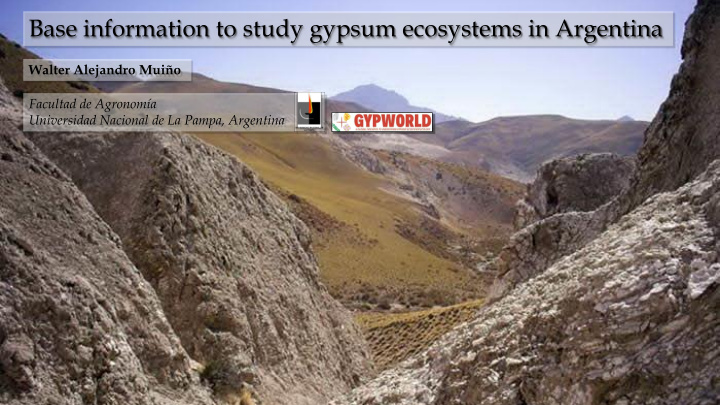



Base information to study gypsum ecosystems in Argentina Walter Alejandro Muiño Facultad de Agronomía Universidad Nacional de La Pampa, Argentina
Geotectonical environment is characterized by zones These deposits occupy closed basins mainly in arid where plates and volcanic areas converge. regions. In the deposits there is a great diversity of gypsum conditions, from coarse to fine crystal granular state.
In Argentina calcium sulphate deposits are from evaporitic origin and they originated in lacustrine or marine basins. They are located in continental sediments and can be identified in fossil and actual deposits. Marine evaporitic deposits cover broad areas. They have a great thickness and reach an average of 90.7 % calcium sulphate. Lacustrine evaporitic deposits cover limited areas and reach an approximate content of 85% calcium sulphate.
Gypsum deposits in Argentina North West Region South West of Mesopotamia West and Central West Region Buenos Aires-La Pampa Neuquén Basin
South West of Mesopotamia and Buenos Aires – La Pampa regions Hernandarias and Luján-Lobos geological formations Origin: Pleistocene from lacustrine basins
North West Region Origin: Late Tertiary from lacustrine basins Vegetation in highland saline environments Tolar Grande, Salta Gypsum outcrops in Tapia, Tucumán Gypsum areas in Recreo, Catamarca
Baccharis tola Xenophyllum poposum Artemisia copa Parastrephia quadrangularis Adesmia horrida Parastrephia lucida Senecio nutans
West and Central West Region Origin: Tertiary (Medium Miocene) from lacustrine basins Angualasto, San Juan Rodeo, San Juan Sierra de los Llanos, La Rioja Guasayán, Santiago del Estero Cerro Blanco, San Juan
Cordobia agentea Prosopis torquata Aspidosperma quebracho-blanco Ximenia americana Larrea divaricata Parkinsonia praecox
Neuquén Basin Origin: Jurassic – Cretaceous from marine coastal deposits Formations: Auquilco Huitrín Allen Roca
Landscape components from Auquilco Formation in Mendoza Angel cavern, nearby Ranquil Norte Gypsum quarry in Las Minas stream Las Leñas Valley
Landscape components from Auquilco Formation, in Neuquén Gypsum quarry in Río Negro Valley, Allen Formation
Azorella prolifera Frankenia fischeri Argylia robusta Jarava neaei Pappostipa humilis Atriplex patagonica
Therefore: The Neuquén Basin was the selected region to make our survey works within the framework of GYPWORLD project. Gypsum areas from Buenos Aires-La Pampa, South West of Mesopotamia and West and Central West of Argentina regions do not constitute extensive outcrops, and present a generalist vegetation with crops and exotic species. Gypsum areas from North West region are above 3500 meters over the sea level with very scarce halophile vegetation. However, the Neuquén Basin is a clear exponent of biological elements from the South American Dry Diagonal. It presents arid conditions with broader areas, landscapes with scarce current disturbance and peculiar floristic components from arid lands with several endemic species, all of them considered a key for conservation efforts on biodiversity.
Photographic acknowledgements: Aubert, Serge Prina, Anibal Redonte, Gabriel Zanette, Damián Instituto de Botánica Darwinion Google Earth
Recommend
More recommend